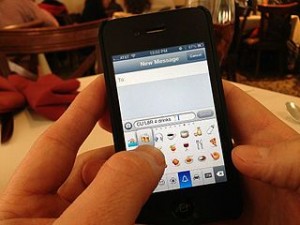If a pilot had to use his stubby fingers to indicate on a screen where he wants to land, flights to Chicago would surely end up in Indianapolis or Lake Michigan.
Touchscreens tend to be oblivious to my commands. The ones I try to use always seem uncertain about whether anyone is actually present. This problem of not noticing me might show up on a self serve scanner at a grocery store, at an ATM, in my car, or maybe just an ordinary phone.
These screens make me feel like I’m knocking on doors that no one wants to answer. Maybe this what it is like to be ghosted by a machine. Or perhaps I’m slow to pick up some sort of cosmic cue that my number is up. It’s also just a little demeaning to encounter a customer service robot that won’t talk to you.
My wife wonders why I don’t text more. She must be kidding. In my hands, pushing the crummy images of keys on a phone is the equivalent of trying to play an ‘air guitar’ louder. It is no surprise that texting rates are higher with girls and women. Their fingers come closest to fitting on the fake touch keyboards. I know a few guys who text. But I suspect farmers and men who do a lot of manual labor aren’t big on thumbing their way through a message.
Of course its all most younger users know. But they should at least consider the possibility that touchscreens are one of the least satisfying electronics “innovations” of our times. They seem to be used by manufacturers because it is cheaper to make a virtual switch than an authentic one. And since we think we need to carry a computer around in our pocket, a virtual keyboard is going to be part of the package. But I would be happier if this this failure of electrical design and execution is not considered some sort of achievement.
Public touchscreens are even worse. Their smears accumulate from the fingers of countless others, meaning that we are picking up involuntary lab specimens of everyone who came before us. We might as well be kissing doorknobs.
The cooling and heating in one of our cars is controlled using a touchscreen, often giving us Phoenix heat when we would prefer mountain cool. A good new car will likely have real click-stop knobs for controlling temperatures and fans. In a word, they are ergonomic and much more satisfying to use.
All of this makes me wonder if the displays in airliners are touchscreens. We should hope not. The controls that matter in planes are probably real keypads, reliable switches or levers adjusted manually. If a pilot had to use his stubby index finger to indicate on a screen display where he wants to land, flights to Chicago would surely end up in Indianapolis or Lake Michigan.
A tech guy at National Public Radio describes my condition as “zombie fingers.” Somehow my digits aren’t producing enough of the tiny electrical field a screen needs in order to sense a command. The solution is apparently a “capacitive stylus,” a sharp tool that a person keeps with them that will generate the necessary electrical field. Think of it as a sharp pencil, and probably one that can easily be misplaced until someone has the misfortune of sitting on it.
![]()


